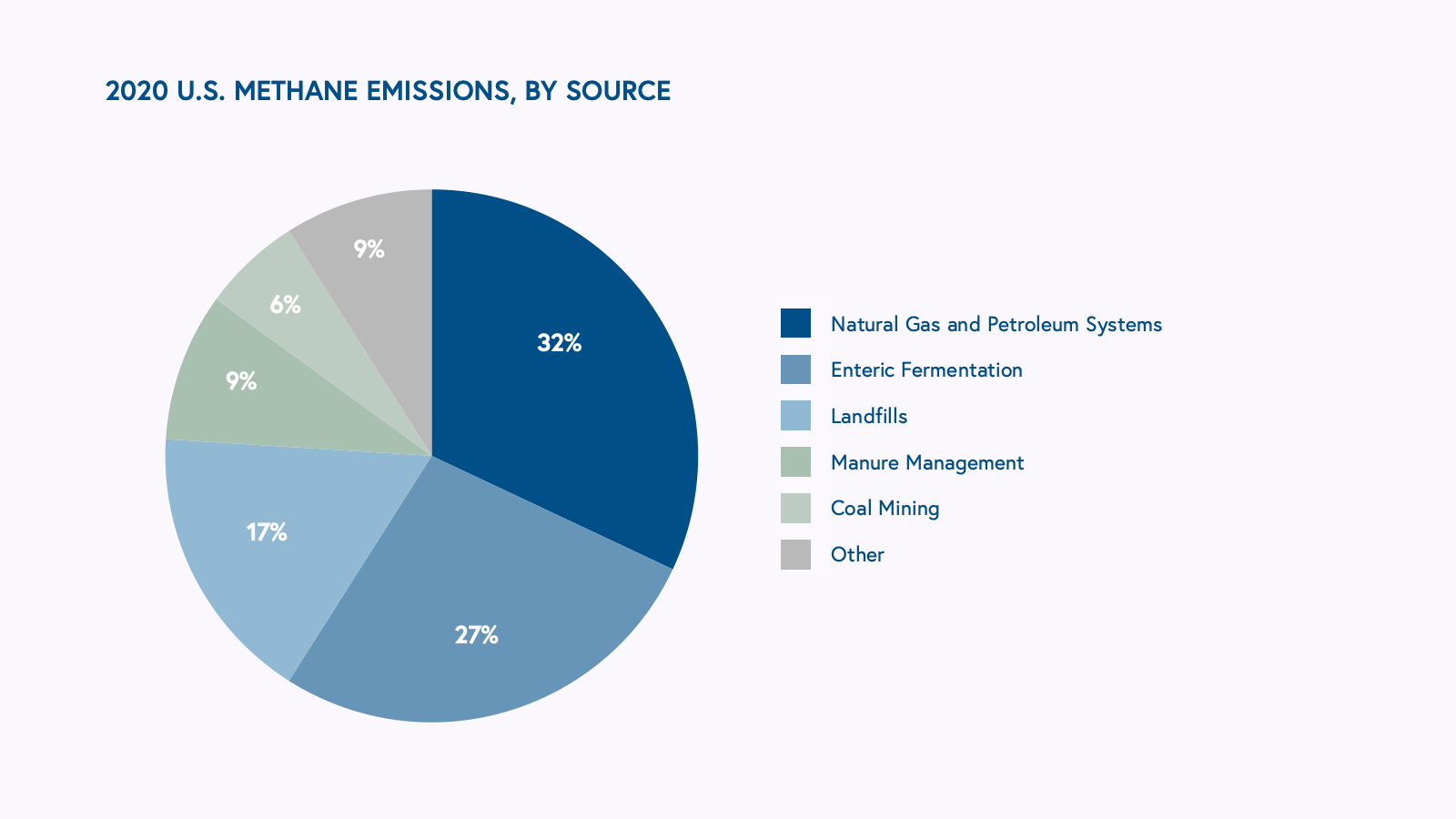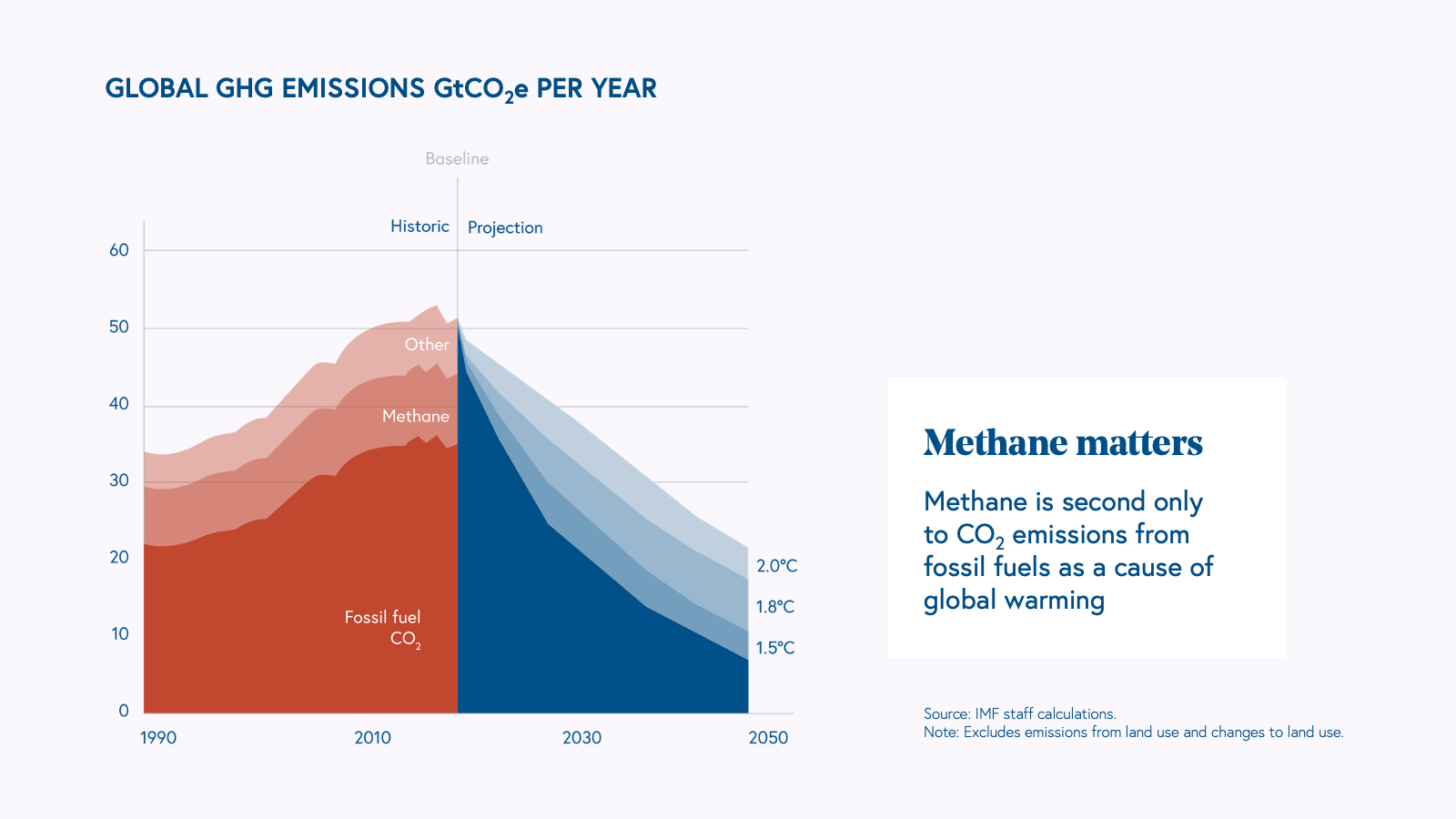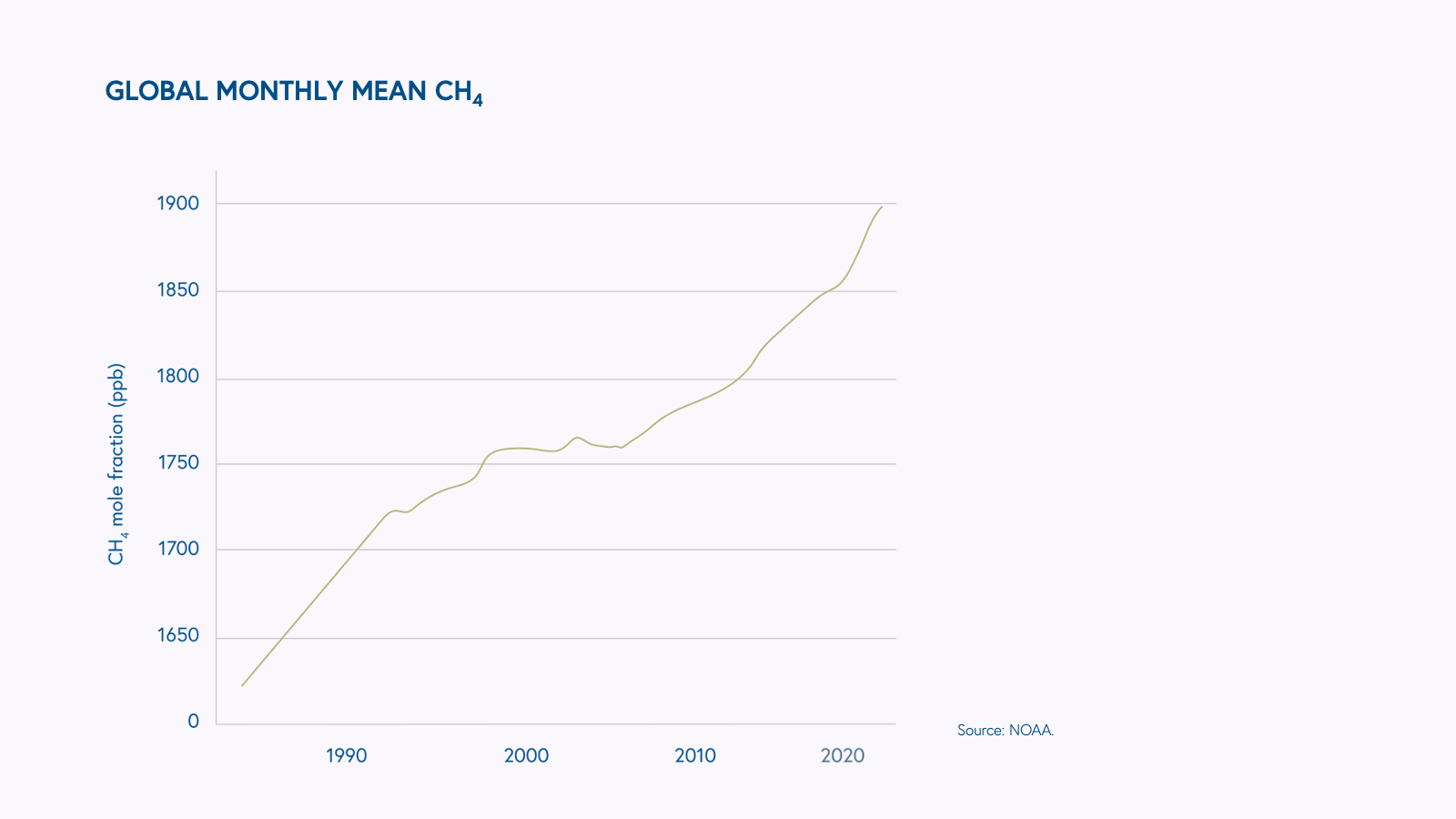Methane: the other greenhouse gas technology must tackle
Carbon dioxide's short-lived cousin is wreaking havoc on the planet. Here's how technology can help us curb its damage.
If you could snap your fingers and immediately combust 100% of the world’s methane (CH4) into carbon dioxide (CO2), would you do it?
Much of the climate change conversation has focused on abating, capturing, and removing CO2, so it wouldn’t be too surprising if you were to answer the question above with a resounding “no.” But we think such a quick answer would be mistaken. For us, the answer to the question above is far less clear-cut: a “maybe” at the very least and even verging on “yes.” Here’s why.
The problem with methane
Methane is everywhere. It’s a gas that’s produced as organic matter decomposes, in places like landfills and wastewater treatment plants. Livestock also produce methane as they digest through a process called enteric fermentation—that’s when bacteria in cattle and sheep break down and ferment food, producing methane as a byproduct.
Large amounts of methane are locked away in seafloor sediments and polar ice caps, which threaten runaway methane emissions if and when those ice caps melt. And, of course, natural gas, the fossil fuel we use to power many of our homes and industrial applications, is largely methane.

Source: Environmental Protection Agency
Although methane hasn’t garnered the same public attention as carbon dioxide, it’s actually the far more dangerous greenhouse gas of the two. The reason why has to do with how greenhouse gasses work.
Greenhouse gasses trap heat in Earth’s atmosphere by absorbing thermal radiation from sunlight that bounces off the Earth’s surface. Because of its chemical structure, methane absorbs far more of this thermal radiation than carbon dioxide does: about ~120x more over a 10-year horizon, ~85x more over a 20-year horizon, and ~25x more over a 100-year horizon.
As you can see, the global warming potential of methane relative to carbon dioxide decreases rapidly with time. This is because methane naturally and quickly breaks down in Earth’s atmosphere, making it a short-lived greenhouse gas. Specifically, methane has a half-life of about 10 years in the atmosphere before it is oxidized to carbon dioxide and water. Meanwhile, carbon dioxide remains in the atmosphere for thousands of years.
Some might argue that any focus on methane would be myopic due to its short half-life, but we actually think the opposite: Precisely because methane wreaks so much havoc in so little time, we need to talk about it more.
There are two main reasons why we need to talk more about methane:
- We need to buy more time.
- We have no time to waste.
First, we need to buy time for the most transformational deep climate tech companies to come online and save our planet. For example, nuclear fusion and direct air capture are transformational technologies that have made significant strides in recent years, but it’ll likely take several years before they’re commercially available.
Second, we simply have no time to waste. The International Monetary Fund (IMF) estimates that we’ll need to reduce methane emissions by up to 50% if we want to hit the climate goals outlined in the Paris Agreement. Many countries have set Net Zero targets for 2050, but even if we hit those targets, the planet will have suffered immense damage in the meantime: in the decades leading up to Net Zero, the planet could still warm by another ~1 degree Celsius, which would cause catastrophic harm to wildlife and expose more people to extreme climate events, like severe heat or coastal flooding. We need to act now, and tackling methane is a high-leverage bet for mitigating climate change.

Source: IMF. GHG stands for “greenhouse gas.”
“GtCO2e” stands for “gigatons of CO2 equivalent.” Currently, experts are using a conservative 25x multiplier for methane. That is, 1 ton CH4 = 25 tons CO2e. Experts are landing on a 25x multiplier because, as mentioned, CH4 has ~25x more global warming potential than CO2 in a 100-year time frame. That said, we think this is conservative and perhaps could be re-evaluated to a shorter time frame.
Global tailwinds for technology addressing methane are emerging
Thankfully, the world has begun waking up to the destructive effects of methane. One reason is that methane has started entering the news cycle. The most notable recent example was the Nord Stream 2 pipeline explosions. This pipeline between Russia and Germany, which has an annual capacity of ~30 trillion gallons of natural gas, suffered explosions in late September 2022, sending hundreds of thousands of metric tons of methane into the atmosphere. According to Bloomberg, one way to think about the short-term climate impact of these leaks is that they effectively wipe out 40% of the gains accrued from electric vehicle adoption in 2022.
Governments have started implementing policies, too. More than 120 countries have signed the Global Methane Pledge, a commitment to cut methane emissions by 30% by 2030. The United Nations established the International Methane Emissions Observatory (IMEO) to measure and report on global methane emissions. Both the European Union and the United States governments have articulated separate methane strategies, committing billions of dollars towards methane reduction and observation.
These tailwinds are important. As discussed, we need to buy time, and we have no time to waste. Methane has accounted for roughly 30% of global warming since the pre-industrial era and is entering the atmosphere faster than at any other time since we began keeping track in the late 1900s. In fact, according to data from the United States National Oceanic and Atmospheric Administration (NOAA), even as carbon dioxide emissions decelerated during the 2020 lockdowns, methane emissions continued to accelerate.

Source: NOAA
Technologies tackling the methane crisis
The timing is ripe for startups to tackle the methane crisis. As we’ve tracked the methane space, we’ve seen four categories of startups:
- Monitoring: As noted, governments around the world are applying pressure on industries around the world to monitor exactly how much methane they are emitting. Startups capitalizing on this opportunity are building new and improved cameras (typically what are known as “hyperspectral” cameras) that can detect methane leakages, which are invisible to the naked eye. Startups are putting these sensors on the ground (Kuva), satellites (Pixxel Space, Orbital Sidekick), drones (SkyX), and even balloons (World View). Importantly, however, government and non-profit initiatives are also tackling the monitoring space. For instance, NASA’s Orbiting Carbon Observatory (OCO) has launched a couple of hyperspectral satellites to monitor methane. MethaneSAT, a subsidiary of the Environmental Defense Fund, will soon be launching what it deems the “most advanced methane-tracking satellite in space.”
- Flaring: Flaring is a controversial practice typically performed at oil and gas sites to burn off unusable methane into carbon dioxide. However, flaring has come under recent attack for its inefficiencies. According to research by Science, while we have traditionally assumed that flares eliminate 98% of the methane passing through them, they only eliminate ~90%. Startups like Frost Methane are building smarter, better flares that not only eliminate methane at higher efficiencies, but also help to monitor methane emissions (see point above). Meanwhile, M2X Energy and Emvolon are converting flare gas into useful chemical products like methanol.
- Reduction: We can also work to reduce methane directly from the source. In the oil and gas industry, this might mean reducing our usage of natural gas although such a prospect would likely be infeasible and indeed perhaps even undesirable given the energy crisis we’ve been facing. Most of the efforts to reduce methane have come from the food and agriculture industry, to reduce emissions from livestock. For example, startups like Blue Ocean Barns and Symbrosia are developing seaweed-based feed additives to reduce the amount of methane cows emit when they burp and fart.
- Capture: Although “carbon capture” has come to exclusively mean “carbon dioxide capture,” we think the definition should be understood more broadly to include methane, which is, after all, also a carbon compound. Indeed, we will derive immense climate benefits by capturing methane even after it has been produced or emitted. This is especially lucrative because methane is a very efficient source of energy and therefore is a valuable and useful compound in and of itself. We’re seeing companies like Osmoses developing novel membranes to efficiently separate and capture methane at the source of emissions. Our portfolio company Windfall Bio is using methane-eating microbes known as “methanotrophs” to consume methane from the air and convert it into organic fertilizer.
What's next for reducing methane emissions
Methane sets the rhythm for climate change in the near-term, but it hasn’t occupied the tenor in the conversation. While that has begun to change, as evidenced by governmental initiatives, we think it’s time to talk more about the dangers of methane and build solutions to decrease methane emissions.
In this piece, we’ve identified several key technological levers companies can pull to reduce the amount of methane in the atmosphere. These technologies will be instrumental in saving our planet. One common thread we’ll be tracking across all these companies, however, is the difficulty of the sales motion. Indeed, these companies will need to sell into industries like oil and gas, food and ag, and governments, all of which can be difficult to penetrate. Oil and gas companies have long, multi-step contracting processes. Farmers need to see the clearest of clear ROIs, especially as market and commodity swings are pushing profits downward. Governments require companies to go through a cumbersome bidding and procurement process.
Nonetheless, we’re excited to back startups that reduce methane while also delivering commercial benefits. While we (likely) won’t find a way to instantaneously combust all methane into carbon dioxide, we hope that all future technologies, in combination, will drive the amount of methane in our atmosphere to 0. If you’re building a company tackling the methane problem, please reach out at climate@bvp.com!





